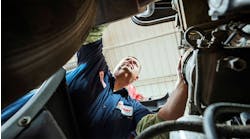Analyzing the oil in your vehicle is like sending your blood to the lab for tests. An engine oil analysis can provide clues about the health of your engine – without any invasive surgery.
By analyzing a sample of used engine oil, you can determine the amount of contamination, the wear rates and overall condition of your engine. The real benefit of an oil analysis is that it acts as an early warning system, alerting you to potential problems before they become an equipment failure.
And oil analysis isn’t for just one kind of driver or one kind of vehicle. The tests benefit all engines, from passenger cars to fleet vehicles to agricultural equipment.
How to perform an analysis
First, you’ll need to purchase an oil analysis kit. Many Cenex brand dealers and CHS cooperatives sell LubeScan® kits, which contain everything you need for analysis. You can also find kits online and at auto parts stores.
You’ll then extract a small sample of used engine oil from your vehicle and mail this to the lab for testing.
Interpreting your results
All LubeScan kits are sent to ALS, a global testing service, for analysis.
Technicians will check for elemental metals, including the presence of metals and other elements, such as aluminum, chromium, iron, copper, lead, calcium and more. Knowing the levels of these materials can help you identify wear patterns in a specific part of the engine. High amounts of wear metal usually indicate an abnormal wear or corrosion problem.
Technicians will also check for insoluble matter like carbon, fuel and dirt. The insolubles test measures how fast the oil is oxidizing and receiving contaminants, and how effectively the system's oil filtration is functioning.
Analysis will measure the oil’s viscosity, its alkalinity or acid level and if the proper level of detergents and anti-wear additives are present. If your oil falls out of the range it’s supposed to be, the oil could have been overheated or contaminated.
The LubeScan report will detail the results of these tests and provide an overall condition of the sample, ranging from normal to severe. If you’ve used LubeScan before, the report will include any changes from earlier analysis.
How analysis can save you money
The benefits of oil analysis go beyond preventative maintenance.
If you’re considering buying a new car, vehicle, motorcycle or even diesel machinery, an oil analysis can help identify any issues lurking under that washed and waxed hood. You might want to reconsider your purchase if a lab report shows high levels of metal in the oil.
For fleet managers, oil analysis can help minimize downtown, as well as safely extend drain intervals, meaning less money spent on oil, filters and labor.
Make the most of your results
Oil analysis shouldn’t be a one-and-done item on your maintenance checklist. Although a single sample is useful in providing a snapshot evaluation, especially where a component problem is suspected, used oil analysis is best used when results can be compared to many samples taken over a period of time.
We recommend that diesel engines be analyzed monthly or every 250 hours and gasoline engines every 3,000 miles.
CLICK HERE to find a Cenex dealer near you for your LubeScan kit.



